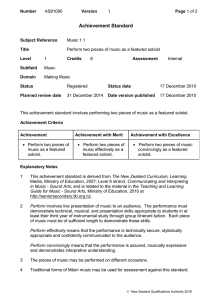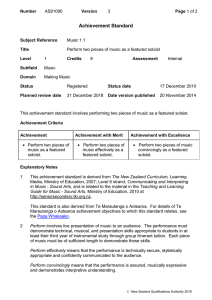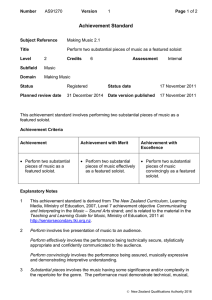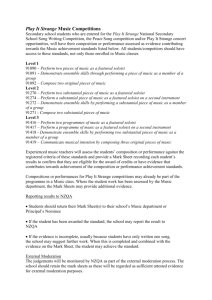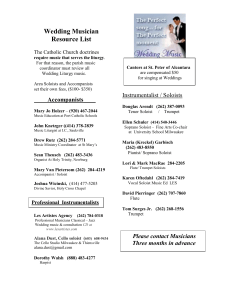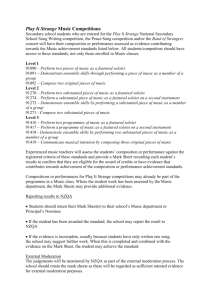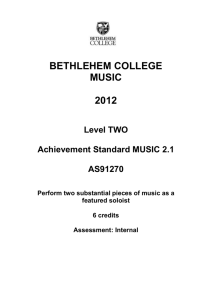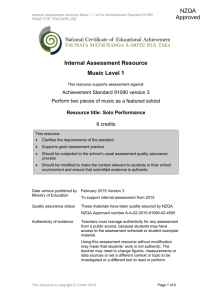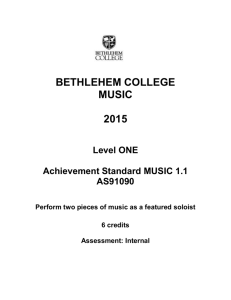NCEA Draft Resource Template - Bethlehem College .::. Welcome
advertisement
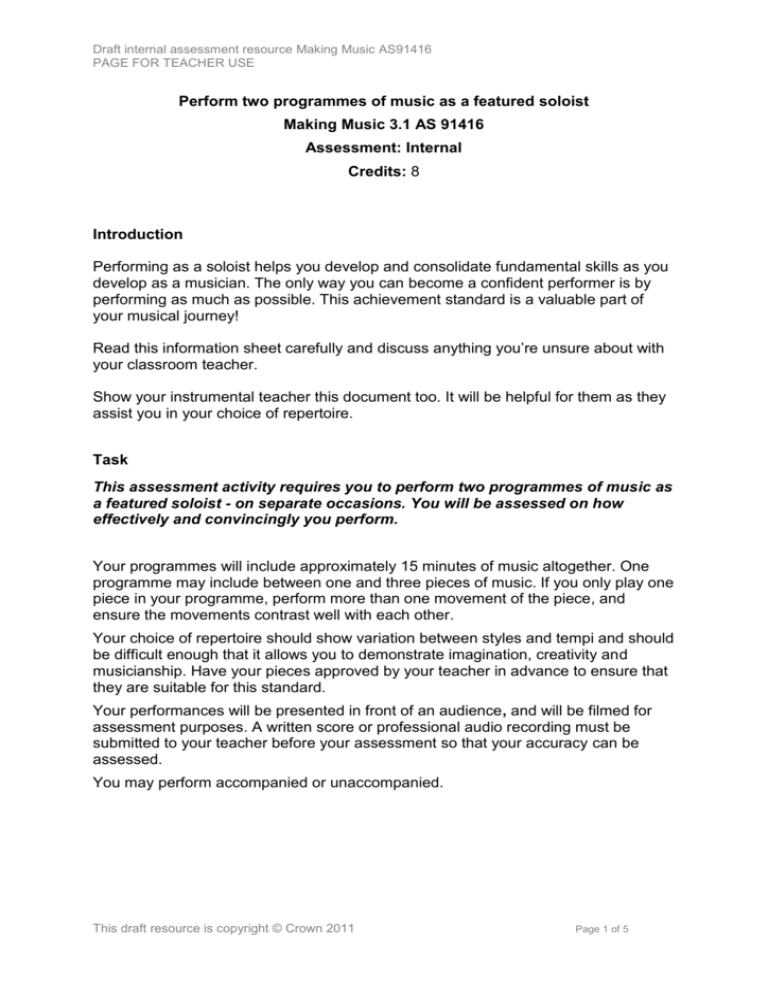
Draft internal assessment resource Making Music AS91416 PAGE FOR TEACHER USE Perform two programmes of music as a featured soloist Making Music 3.1 AS 91416 Assessment: Internal Credits: 8 Introduction Performing as a soloist helps you develop and consolidate fundamental skills as you develop as a musician. The only way you can become a confident performer is by performing as much as possible. This achievement standard is a valuable part of your musical journey! Read this information sheet carefully and discuss anything you’re unsure about with your classroom teacher. Show your instrumental teacher this document too. It will be helpful for them as they assist you in your choice of repertoire. Task This assessment activity requires you to perform two programmes of music as a featured soloist - on separate occasions. You will be assessed on how effectively and convincingly you perform. Your programmes will include approximately 15 minutes of music altogether. One programme may include between one and three pieces of music. If you only play one piece in your programme, perform more than one movement of the piece, and ensure the movements contrast well with each other. Your choice of repertoire should show variation between styles and tempi and should be difficult enough that it allows you to demonstrate imagination, creativity and musicianship. Have your pieces approved by your teacher in advance to ensure that they are suitable for this standard. Your performances will be presented in front of an audience, and will be filmed for assessment purposes. A written score or professional audio recording must be submitted to your teacher before your assessment so that your accuracy can be assessed. You may perform accompanied or unaccompanied. This draft resource is copyright © Crown 2011 Page 1 of 5 Draft internal assessment resource Making Music AS91416 PAGE FOR TEACHER USE To achieve in this standard: Your performance must demonstrate technical, musical, and presentation skills appropriate to the fifth year of instrumental tuition. Technical skills refers to techniques specific to the instrument being used for the performance, for example, bowing, embouchure, breathing, consistency in changing registers, playing techniques, consistency of tone. Secure technical skills refers to appropriate techniques that are consistent throughout the performance. Accuracy refers to the degree of precision as communicated from the written score or the aural transcription, with the understanding that performances are seldom completely accurate. Musicianship refers to musical awareness and understanding of the musical style. This includes phrasing, dynamics, rhythm, articulation, feel, and overall maturity of interpretation. Presentation refers to the sense of performance appropriate to the genre and style of the music, appropriate posture and stagecraft, and, for achievement with excellence, communication skills. Communication skills refers to committed rapport with the music, instrument and audience. Assessment Conditions Assessment dates: There will be three performance evenings which are intended to be friendly and supportive occasions: Term One: Wednesday 18 March Term Two: Wednesday 10 June Term Three: Wednesday 9 September You are required to perform a full programme for the second and third performance evenings. You may also perform a full programme at the first performance event, but one piece would also be satisfactory. The first performance evening is intended to be an opportunity for you to get performing early on, and to be given feedback that can inform your performance practice as you work towards the next two events. All of your performances will be videoed, and you will be given feedback each time. Your final grade will be generated from the second and third performances The intention is to encourage you with helpful feedback and give you confidence as you prepare for the following two performance evenings. Level 1 and 2 students will join you in these performance evenings, and so with everyone together, it will be a festive celebration of developing talent. It is expected that you support your peers and are part of the audience for the duration of the evenings. This draft resource is copyright © Crown 2011 Page 2 of 5 Draft internal assessment resource Making Music AS91416 PAGE FOR TEACHER USE Like any other assessment, if you do not complete your performance at the agreed time or if you miss it for reasons other than illness or bereavement, you will receive a not-achieved grade. Extensions cannot be granted for performance assessments. If you have a prior and unchangeable booking on any of the three performance evening dates above, you must discuss this with Mrs Graham within a week of receiving this notice. Accompaniment of your solo: If you are accompanying yourself as you perform, then the assessment is holistic. (You will be assessed on your accompaniment also.) If you require an accompanist it is your responsibility to arrange this well in advance of the performance date. The school cannot accept responsibility if your accompanist fails to attend your performance on time, this is a private arrangement between you and them. Copy of your music: You will need to hand a named manila folder and copies of each piece of music or aural transcription that you are playing for your performance to Mrs Graham well in advance of the performance. This draft resource is copyright © Crown 2011 Page 3 of 5 Draft internal assessment resource Making Music AS91416 PAGE FOR TEACHER USE Assessment schedule: Achievement Perform two programmes of music as a featured soloist Achievement with Merit Perform two programmes of music effectively as a featured soloist Achievement with Excellence Perform two programmes of music convincingly as a featured soloist Evidence/Judgements for Achievement Evidence/Judgements for Achievement with Merit Evidence/Judgements for Achievement with Excellence The student has performed two programmes of music as a featured soloist. To do this, they have: Demonstrated technical skills and a level of musicianship appropriate to a fifth year of study through group itinerant lessons Eg: a drum student shows they can perform with consistency. Repeated rhythms are the same each time and some changes in dynamics are audible. The student is able to negotiate fills without disrupting the beat Performed with some understanding of phrasing and intonation and performed all performance directions Eg. A brass student breathes between phrases thoughout their performance. They start in tune and maintain this for most of the performance. They demonstrate a range of different articulations, as are indicated in the The student has performed two programmes of music effectively as a featured soloist. To do this, they have: Demonstrated consistent technical skills and secure musicianship Eg: a drum student performs with confident consistency. They demonstrate a few different rhythms, and each repetition of the same rhythm is exactly the same. There is a marked difference between contrasting dynamic sections, as indicated by the original material. The student plays fills easily, incorporating them into the flow of the music Performed with a sense of style throughout their performance and appropriately communicated the composer’s intention Eg: a brass student breathes between phrases The student has performed two programmes of music convincingly as a featured soloist. To do this, they have: Demonstrated convincing technical skills and musicianship, allowing for freedom of expression Eg: a drum student performs with precision but not stiffness. They perform a range of different rhythms with ease and interpret the music to include their own dynamics, which subtly enhance the music. They incorporate fills and ornaments at appropriate times and work these seamlessly into the piece. Engaged the audience throughout the performance and shown confidence in their stage presence and command of their performance through their posture and stage manner The student exudes confidence, from the This draft resource is copyright © Crown 2011 Page 4 of 5 Draft internal assessment resource Making Music AS91416 PAGE FOR TEACHER USE original material. Presented themselves with some confidence and show a clear understanding of performance etiquette. Eg: the student introduces themselves clearly and knows the title and composer of their pieces. They have reasonable posture apprioriate to their instrument. They acknowledge applause at the end of their performance in an appropriate manner. and uses dynamics to further emphasize the phrases in the music. They use a range of articulations to communicate the intentions of contrasting genres or styles of music. They are generally in tune throughout the performance. Engaged the audience in their performance and shown confidence as a performer Eg: The student introduces themselves and their pieces with confidence. They have good posture and appear self-assured in their ability as a performer. They make some attempt during the performance to engage the audience, and acknowledge applause at the end of their performance in an appropriate manner. moment they set foot on stage to the time they leave the stage. They introduce themselves and their pieces with ease and have good posture throughout their performance. They hold the attention of the audience throughout the performance. They acknowledge applause with grace at the end of each piece and at the conclusion of the performance. Final grades will be decided using professional judgement based on a holistic examination of the evidence provided against the criteria in the Achievement Standard. This draft resource is copyright © Crown 2011 Page 5 of 5

